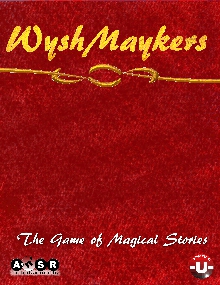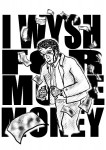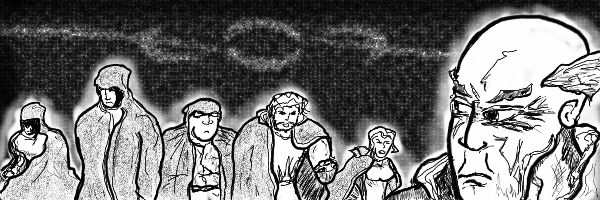WyshMaykers
WyshMaykers is a stand-alone game powered by -U- the Game of Stories system and published by A’n’SR Entertainments.
By Aaron and Stephanie Richardson

Welcome to the twentieth Designer’s Diary, a regular column where designers are given the opportunity to take readers on an in-depth ride through the design and development process of their system, setting, or product. If you’d like to share your product in the Designer’s Diary column, send a message to aaron@roleplayerschronicle.com.
Designer’s Description
WyshMaykers is a stand-alone, rules-lite game about modern-day magic. Okay… that’s the sound-bite version of the description. The expanded version is that it is a game about people with the power to make anything they want come true. No… really. Anything. They have the power to Wysh whatever they can will into happening. Potentially world-changing individuals in a “don’t let them know you exist” modern-day world.
Purpose
We made WyshMaykers for 2 reasons: Trial and Fun.
Trial: We wanted to try to make a stand-alone game using our game system -U- the Game of Stories. We think that the game is a solid rules-lite game system and we’ve played dozens of settings using the rules. We knew, from a business point of view, that role-playing games make money by releasing supplements or new books. We also felt (and now have proof) that DriveThruRPG.com’s bulk of sales come from new games vs. supplements. So, with all of that in our minds, we decided on 3 Settings that we wanted to release as stand-alone games using the -U- rules. After some consideration, WyshMaykers, we decided, was our trial to see if it went over well and to get the bugs out of the process before we published the other two games.
Fun: We published WyshMaykers because it is a fun game, especially for creative people. If you, your friends, and a lot of people who aren’t your friends could do anything they could think of it would be an interesting world. The possibilities are just endless of what a player can come up with. Add into it a society that believes there should be some controls in place to keep the world from blowing up, and the chance for personal agendas to collide. We just had to make this game and let other people Wysh (sorry, couldn’t help it) up their own stories with it.
Influences
We (the creators, Aaron and Stephanie Richardson) are just geeks. We have Alex Ross posters in the living room, we carry dice and -U- character records to restaurants to game on the go, our child’s first words included a form of the word Batman. We really enjoy this stuff. Our influences, naturally, come from these common interests.
Stephanie has a Green Lantern shrine in the corner of the living room (and, yes, she liked him before Geoff Johns even started writing him). GL’s power: he has a ring that can do anything he can think of… within reason. That was an influence. Aaron remembered fondly an adventure with his brother (and some others) where a character got the chance to make a Wish spell happen with humorous results. That was an inspiration. And somewhere in all of the discussions about cool Settings to play in using -U-, we were reading Harry Potter and the Dresden Files at the same time. These made us want to do a story about wizards and people with magical powers of some kind.
A few dinner conversations, a quick setting write-up (yes, it is that easy to make a Setting/world with -U- the Game of Stories) and a few games later, Green Lantern and Harry Dresden and Harry Potter and a funny Wish incident from days past merged into the backbone of WyshMaykers.
Research
Since WyshMaykers is a modern-day setting of a game, we did very little research in the way of when the game took place. In fact the most research we really did was into past events that WyshMaykers might have influenced. That was fun, but nowhere near as extensive as an honest historical game. In truth, with characters that can Wysh what they want, the future and their goals are far more important to the game than what might have gone before. For a possible supplement, we’ve been researching the mythical Middle-east a bit, but we’re not sure how much to include in the final product.

Art Direction
The art for WyshMaykers was done in 2 phases. The book is really 2 books in one. Part 1 is the rules. It has a white background and is very… clinical… in its content. We tried to make the art convey some of the Wyshes characters might want to do in the game to help add some flavor to the dry part of the book.
The second part of the book is the story that explains the world. All the art there appears inside sidebars that explain certain aspects of the world in detail. For these sidebars, the art matches the content as best it can.
Gaming Experience
WyshMaykers is designed to provide a “let your imagination run wild” type of experience. These characters can make anything the player can think of happen. This makes for a very character-based game. In fact, the whole method of making a Story Outline (adventure) is to list a starting event, a possible solution or two and then all the characters’ and factions’ motivations and probable actions in the game. From there it is the will of the characters and the movement of various factions toward their goals that drives the game and story forward.
This game, unlike many, really plays better with less players. We’re a fan of Duet gaming (one player, one Story Referee). This game fits well for that type of gaming, since character is such a focus of the game world.
Comparison
WyshMaykers is something like Mage (from White Wolf) stripped down of its various factions and houses with a bit of emphasis on the idea of power being a responsibility and being corrupting. It is not very rules intensive and focuses on character and story. In fact, now thinking about it, it might very well be an unintentional love-letter to the old White Wolf games we played in the 90s.
Development Process
The game first began as one of 3 games that we decided we wanted to put out using the -U- the Game of Stories core rules. With that, we looked at the core rules and decided what should stay and what would be in the way of the game. We eventually cut out the Abilities portion of the -U- rules, and created a new thing called Modifiers that helped balance the game a bit. As a side-note, we ended up publishing Modifiers as a free supplement to -U- during the development of WyshMaykers.
After getting the basic rules in place (which was pretty easy), we then moved to deciding how to present the world. We knew we wanted the game to be very character focused. We also knew that the -U- rules would fit into a few pages and would be separated from the Setting information. Aaron also always wanted to do a game where the world was explained via a story ala Castle Faulkenstein (R. Talsorian Games). WyshMaykers seemed to be the best one of the three to try the idea out with. So, we began the writing.
First came the official rules tweaks. They were 90% done for us, we just had to update some text, add a little stuff, and make everything else all Wysh-ified. Next came the story portion. We wrote down the key concepts that we wanted to talk about in the Setting. Things like, the Three Laws of the WyshMaykers, the Society of WyshMaykers, the way a Wysh looks, the different positions within the Society of WyshMaykers, etc. Then we crafted the sidebars about the topics. Finally, we drafted the story that explained the Setting to the players/readers.
Next came the layouts. We wanted the game rules to be plain and the Setting story to be bold. We played with tons of different combinations of layouts, symbols, inversions, ideas, and drawings. Finally we found a little shape in one of our art programs that we modified, duplicated and flipped that became the WyshMaykers “symbol” (it kinda looks like a W and an M on top of each other). From there, the layout (and the art) kind of flowed.
Using the “symbol” we began on the art. We drew the rules art first and included as little of the symbol as possible in the drawings. And yes, we drew all the art for the book ourselves (for better or worse). Once the rules art was done, we then made a list of all the art we needed for each sidebar. We then began drawing pieces that tied to the content in the sidebars. Each of the sidebar pieces contained the “symbol”. The art took the longest time out of any of the processes. We totally have an appreciation of people who do book art professionally, we don’t know how you do it.
Finally, we edited the book. A lot. The editing process was usually Aaron printing off the book and Stephanie tearing it apart line-by-line. On record, we had 4 revisions of the book before we finally were happy enough with the product to release it, though that’s just the times that we made it all the way through.
Overall, the process took about a year and a half with a halt in the middle to publish an Updated and Revised edition of -U- the Game of Stories with some of the lessons learned during the WyshMaykers creation process.





